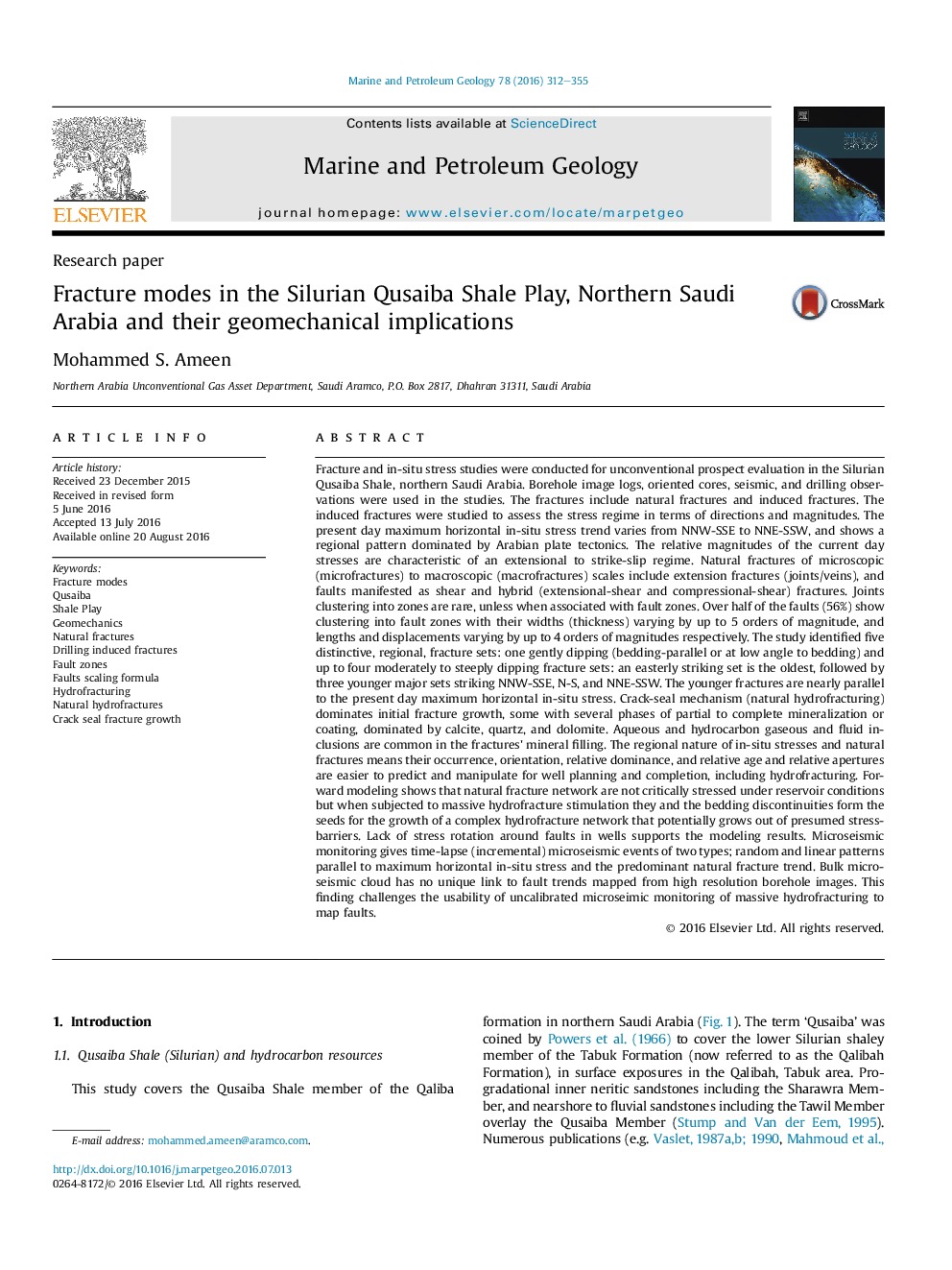| کد مقاله | کد نشریه | سال انتشار | مقاله انگلیسی | نسخه تمام متن |
|---|---|---|---|---|
| 6434391 | 1637149 | 2016 | 44 صفحه PDF | دانلود رایگان |

- Extensional to strike-slip in-situ stresses dominated by Arabian plate tectonics.
- Extension, extensional-shear (hybrid), and shear natural fractures.
- Multiphase crack-seal hydrofracturing and rejuvenation with mainly calcite, quartz, and dolomite fills.
- Younger natural fractures parallel/nearly parallel to maximum horizontal in-situ stress.
- Hydrofracturing resulted in complex network and out of presumed stress-barriers growth.
Fracture and in-situ stress studies were conducted for unconventional prospect evaluation in the Silurian Qusaiba Shale, northern Saudi Arabia. Borehole image logs, oriented cores, seismic, and drilling observations were used in the studies. The fractures include natural fractures and induced fractures. The induced fractures were studied to assess the stress regime in terms of directions and magnitudes. The present day maximum horizontal in-situ stress trend varies from NNW-SSE to NNE-SSW, and shows a regional pattern dominated by Arabian plate tectonics. The relative magnitudes of the current day stresses are characteristic of an extensional to strike-slip regime. Natural fractures of microscopic (microfractures) to macroscopic (macrofractures) scales include extension fractures (joints/veins), and faults manifested as shear and hybrid (extensional-shear and compressional-shear) fractures. Joints clustering into zones are rare, unless when associated with fault zones. Over half of the faults (56%) show clustering into fault zones with their widths (thickness) varying by up to 5 orders of magnitude, and lengths and displacements varying by up to 4 orders of magnitudes respectively. The study identified five distinctive, regional, fracture sets: one gently dipping (bedding-parallel or at low angle to bedding) and up to four moderately to steeply dipping fracture sets: an easterly striking set is the oldest, followed by three younger major sets striking NNW-SSE, N-S, and NNE-SSW. The younger fractures are nearly parallel to the present day maximum horizontal in-situ stress. Crack-seal mechanism (natural hydrofracturing) dominates initial fracture growth, some with several phases of partial to complete mineralization or coating, dominated by calcite, quartz, and dolomite. Aqueous and hydrocarbon gaseous and fluid inclusions are common in the fractures' mineral filling. The regional nature of in-situ stresses and natural fractures means their occurrence, orientation, relative dominance, and relative age and relative apertures are easier to predict and manipulate for well planning and completion, including hydrofracturing. Forward modeling shows that natural fracture network are not critically stressed under reservoir conditions but when subjected to massive hydrofracture stimulation they and the bedding discontinuities form the seeds for the growth of a complex hydrofracture network that potentially grows out of presumed stress-barriers. Lack of stress rotation around faults in wells supports the modeling results. Microseismic monitoring gives time-lapse (incremental) microseismic events of two types; random and linear patterns parallel to maximum horizontal in-situ stress and the predominant natural fracture trend. Bulk microseismic cloud has no unique link to fault trends mapped from high resolution borehole images. This finding challenges the usability of uncalibrated microseimic monitoring of massive hydrofracturing to map faults.
274
Journal: Marine and Petroleum Geology - Volume 78, December 2016, Pages 312-355